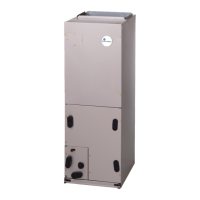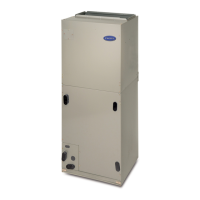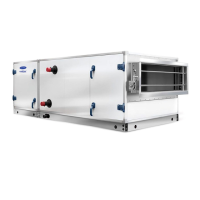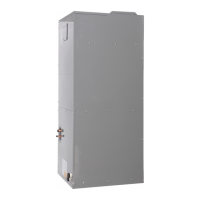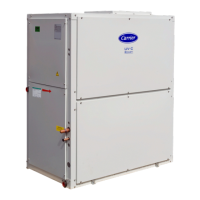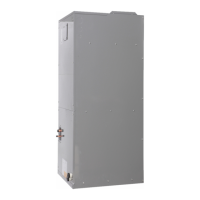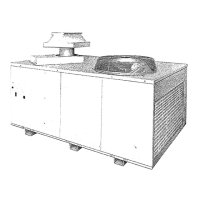99
Table 76 — Alert Limit Configuration
OARH High Alert Limit (O.RH.H)
If the unit is configured to use a return air relative humidity sensor
(Configuration
ECON
ORH.S) and the measured level is
above the configurable OARH High Alert Limit (O.RH.H), then
economizer operation will be disabled. The unit will continue to
run and the alert will automatically reset.
Supply Duct Pressure Low Alert Limit (SP.L)
If the unit is a VAV unit with a supply duct pressure sensor and
the measured supply duct static pressure is below the configu-
rable SP Low Alert Limit (SP.L), then Alert 310 will occur. The
unit will continue to run and the alert will automatically reset.
Supply Duct Pressure High Alert Limit (SP.H)
If the unit is a VAV unit with a supply duct pressure sensor and
the measured supply duct static pressure is above the configu-
rable SP High Alert Limit (SP.H), then Alert 311 will occur. The
unit will continue to run and the alert will automatically reset.
Building Pressure Low Alert Limit (BP.L)
If the unit is configured to use modulating power exhaust, then a
building static pressure limit can be configured using the BP Low
Alert Limit (BP.L). If the measured pressure is below the limit
then Alert 312 will occur.
Building Pressure High Alert Limit (BP.H)
If the unit is configured to use modulating power exhaust, then a
building static pressure limit can be configured using the BP Hi
Alert Limit (BP.H). If the measured pressure is above the limit,
then Alert 313 will occur.
Indoor Air Quality High Alert Limit (IAQ.H)
If the unit is configured to use a CO
2
sensor and the level is above
the configurable IAQ High Alert Limit (IAQ.H), then the alert
will occur. The unit will continue to run and the alert will automat-
ically reset.
Sensor Trim Configuration
The TRIM submenu is used to calibrate the sensor trim settings.
The trim settings are used when the actual measured reading does
not match the sensor output. The sensor can be adjusted to match
the actual measured reading with the trim function. A list is shown
in Table 77.
Air Temperature Leaving Supply Fan Sensor (SAT.T)
This variable is used to adjust the supply fan temperature sensor
reading. The sensor reading can be adjusted ±10°F to match the
actual measured temperature.
Return Air Temperature Sensor Trim (RAT.T)
This variable is used to adjust the return air temperature sensor
reading. The sensor reading can be adjusted ± 10°F to match the
actual measured temperature.
Outdoor Air Temperature Sensor Trim (OAT.T)
This variable is used to adjust the outdoor air temperature sensor
reading. The sensor reading can be adjusted ± 10°F to match the
actual measured temperature.
Space Temperature Sensor Trim (SPT.T)
This variable is used to adjust the space temperature sensor read-
ing. The sensor reading can be adjusted ± 10°F to match the actual
measured temperature.
Limit Switch Trim (L.SW.T)
This variable is used to adjust the limit switch temperature sensor
reading. The sensor reading can be adjusted ±10°F to match the
actual measured temperature.
Air Temperature Leaving Evaporator Trim (CCT.T)
This variable is used to adjust the leaving evaporator temperature
sensor reading. The sensor reading can be adjusted ± 10°F to
match the actual measured temperature.
A1 Discharge Temperature (DTA.1)
This variable is used to adjust the A1 compressor discharge tem-
perature sensor reading. The sensor reading can be adjusted ±10°F
to match the actual measured temperature.
NOTE: Due to the resolution of the control board analog input,
temperature readings less than 50°F will become increasingly in-
accurate as the temperature decreases.
Suction Pressure Circuit A Trim (SP.A.T)
This variable is used to adjust the suction pressure sensor reading
for circuit A. The sensor reading can be adjusted ±50 psig to
match the actual measured pressure.
ITEM EXPANSION RANGE UNITS CCN POINT DEFAULT
SP.L.O SPT lo alert limit/occ –10 to 245 dF SPLO 60
SP.H.O SPT hi alert limit/occ –10 to 245 dF SPHO 85
SP.L.U SPT lo alert limit/unocc –10 to 245 dF SPLU 45
SP.H.U SPT hi alert limit/unocc –10 to 245 dF SPHU 100
SA.L.O EDT lo alert limit/occ –40 to 245 dF SALO 40
SA.H.O EDT hi alert limit/occ –40 to 245 dF SAHO 100
SA.L.U EDT lo alert limit/unocc –40 to 245 dF SALU 40
SA.H.U EDT hi alert limit/unocc –40 to 245 dF SAHU 100
RA.L.O RAT lo alert limit/occ –40 to 245 dF RALO 60
RA.H.O RAT hi alert limit/occ –40 to 245 dF RAHO 90
RA.L.U RAT lo alert limit/unocc –40 to 245 dF RALU 40
RA.H.U RAT hi alert limit/unocc –40 to 245 dF RAHU 100
OAT.L OAT lo alert limit –40 to 245 dF OATL –40
OAT.H OAT hi alert limit –40 to 245 dF OATH 150
R.RH.L RARH low alert limit 0 to 100 % RRHL 0
R.RH.H RARH high alert limit 0 to 100 % RRHH 100
O.RH.L OARH low alert limit 0 to 100 % ORHL 0
O.RH.H OARH high alert limit 0 to 100 % ORHH 100
SP.L SP low alert limit 0 to 5 "H2O SPL 0
SP.H SP high alert limit 0 to 5 "H2O SPH 2
BP.L BP lo alert limit –0.25 to 0.25 "H2O BPL –0.25
BP.H BP high alert limit –0.25 to 0.25 "H2O BPH 0.25
IAQ.H IAQ high alert limit 0 to 5000 IAQH 1200
IMPORTANT: Sensor trim must not be used to extend unit oper-
ation past the allowable operating range. Doing so may impair or
negatively affect the Carrier product warranty.

